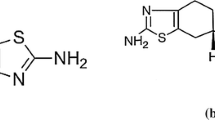Opinion statement
Although dopamine receptor agonists are not simple to use, they are assuming increased importance in the treatment of early and advanced symptoms of Parkinson’s disease (PD). The new agonists, pramipexole and ropinirole, are generally adequate without levodopa for early symptoms and carry the hope for a more acceptable profile of long-term side effects. In the patient with advanced disease, all four dopamine agonists significantly augment th response to levodopa, which reduces the problems of motor fluctuations and drug-related dyskinesia. Understanding the common pitfalls when prescribing these drugs will facilitate their safety and efficacy.
Similar content being viewed by others
References and Recommended Reading
Gottwald MD, Bainbridge JL, Dowling GK, et al.: New pharmacotherapy for Parkinson’s disease. Ann Pharmacother 1997, 31:1205–1217. This review details the comparative features of pramipexole, ropinirole, and cabergoline for patients with early and advanced Parkinson’s disease.
Shannon KM, Bennett JP, Friedman JH, for the Pramipexole Study Group: Efficacy of pramipexole, a novel dopamine agonist, as monotherapy in mild to moderate Parkinson’s disease. Neurolog 1997, 49:724–728.
Kiebertz K for the Pramipexole Study Group: Safety and efficacy of pramipexole in early Parkinson’s disease: a randomized dose-ranging study. JAMA 1997, 278:125–130.
Sethi KD, O’Brien CF, Hammerstad JP et al., for the Ropinirole Study Group: Ropinirole for the treatment of early Parkinson’s disease: a 12-month experience. Arch Neurol 1998, 55:1211–1216.
Adler CH, Sethi KD, Hauser R, et al., for the Ropinirole Study Group: Ropinirole for the treatment of early Parkinson’s disease. Neurology 1997, 49:393–399.
Chase TN: The significance of continuous dopaminergic stimulation in the treatment of Parkinson’s disease. Drugs 1998, 55(suppl 1):1–9. This is a review of current theories of the mechanism underlying the appearance of drug-related complications, such as motor fluctuations and dyskinesia, among patients with Parkinson’s disease.
Agid Y: Levodopa: is toxicity a myth? Neurolog 1998, 50:858–863. This review article disputes the notion that levodopa is toxic and draws the important distinction between reversible side effects and neuronal cell death.
Poewe W: Should treatment of Parkinson’s disease be started with a dopamine agonist? Neurology 1998, 51(suppl 2):521–524.
Goetz CG, Tanner CM, Glantz RH, Klawans HL: Chronic agonist therapy for Parkinson’s disease: a 5 year study of bromocriptine and pergolide. Neurology 1985, 35:749–751.
Factor SA, Sanchez Ramos JR, Weiner WJ: Parkinson’s disease: an open label trial of pergolide in patients failing bromocriptine therapy. Neurol Neurosurg Psychiatr 1988, 51:529–533.
Shulman LM, Minagar A, Weiner WJ: The tolerability and efficacy of pramipexole in patients with idiopathic Parkinson’s disease previously on bromocriptine, pergolide or cabergoline [abstract]. Neurolog 1998, 50:A279.
Lieberman A, Ranhosky A, Korts D: Clinical evaluation of pramipexole in advanced Parkinson’s disease: results of a double-blind, placebo-controlled parallel group study. Neurology 1997, 49:162–168.
Szagedi A, Hilbert A, Wetzel H, et al.: Pramipexole, a dopaminergic agonist in major depression: antidepressant effects and tolerability in an open label study with multiple doses. Clin Neuropharmacol 1997, 20:S36-S45.
Corrigan M, Evans D: Pramipexole, a dopamine agonist, in the treatment of major depression [abstract]. Proceedings of the American College of Neuropsychopharmacology. Honolulu: American College of Neuropsychopharmacology; 1997.
Oertel WH, Pohl M, Pogarell O: Tremor dominant Parkinson’s disease. Proceedings of the Annual Meeting of the European Neurological Society, Issues and Options in the Treatment of Parkinson’s Disease. Nice: European Neurological Society; 1998.
Hoerger TJ, Green M, Bala MB, et al.: Cost effectiveness of pramipexole in Parkinson’s Disease in the United States. Neurology 1998, 50:A298.
Kreider MS, Knox S, Gardiner D, et al.: The efficacy of ropinirole, a non-ergoline D2 agonist, as an adjunct to levodopa (DCI) in patients with Parkinson’s disease [abstract]. Movement Disord 1996, 11(suppl):156.
Olanow CW, Alberts MJ: Double-blind controlled study of pergolide mesylate as an adjunct to Sinemet in the treatment of Parkinson’s disease. Adv Neurol 1987, 45:555–560.
Lieberman AN, Neophytides A, Leibowitz M, et al.: Comparative efficacy of pergolide and bromocriptine in patients with advanced Parkinson’s disease. In Advances in Neurology. Edited by Fahn S, Calne DB, Shoulson I. New York: Raven Press; 1983:95–108.
Lieberman AN, Kupersmith M, Estray E, Goldstein M: Treatment of Parkinson’s disease with bromocriptine. N Engl J Med 1976, 295:1400–1403.
Larsen TA, Newman RP, Lewitt PA, Calne D: Severity of Parkinson’s disease and the dosage of bromocriptine. Neurology 1984, 34:795–797.
Hutton JT, Koller WC, Ahlskog JE, et al.: Multicenter placebo-controlled trial of cabergoline taken once daily in the treatment of Parkinson’s disease. Neurolog 1996, 46:1062–1065.
Author information
Authors and Affiliations
Rights and permissions
About this article
Cite this article
Shulman, L.M. Parkinson’s disease: The proper use of dopamine receptor agonists. Curr Treat Options Neurol 1, 14–20 (1999). https://doi.org/10.1007/s11940-999-0028-2
Issue Date:
DOI: https://doi.org/10.1007/s11940-999-0028-2



